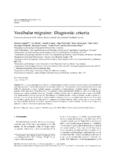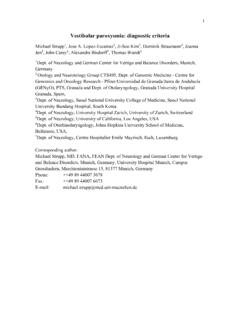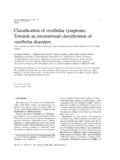Transcription of Bárány Society initiative for the establishment of the ...
1 B r ny Society initiative for the establishment of the international classification of vestibular disorders (ICVD) Instructions to the subcommittees trusted with the definition of a particular disorder/disease Composition of the subcommittee: Every subcommittee will have a chair designated by the classification Committee of the B r ny Society (CCBS). The chair of a subcommittee should be a member of the Barany Society and report to the CCBS. He/she will compose his/her own subcommittee group according to the following guidelines: at least 3 continents represented, at least one clinician with ENT background and at least one clinician with neurology background. Additional expertise from a different background (like vestibular testing or imaging etc) as needed.
2 The input of each member of a working group should be such that it will qualify for authorship, this should encourage small efficient working groups. Time frame for subcommittees: Within 12 months from designation of the coordinator to presentation of first proposal to the CCBS. Internal review process: Each paper undergoes an internal review and consensus process for ICVD Publications in the Journal of vestibular Research 1. Subcommittee completes draft document and determines together with the CCBS ( classification Committee of the B r ny Society ) that it is ready for input from the B r ny Society membership. 2. The draft document is placed on the JVR website and B r ny Society members are alerted via email or other electronic means that a draft document is ready for comments from B r ny Society members and are directed to a dedicated hidden page.
3 Only Barany Society members are directed to this page. 3. Comments are provided by interested B r ny Society members via the JVR website. Note that these comments are not visible to the public but only visible to the Editor of JVR. 4. The Editor of JVR forwards all legitimate comments to the relevant subcommittee chair. 5. The subcommittee chairs at their own discretion responds to individual comments by replying to the member who provided the comment, revising the draft document, both, or neither. The subcommittee chair will involve subcommittee members as they see fit. 6. After some period of time, approximately 3 months, a revised document is prepared by the subcommittee taking into account any comments received from the B r ny Society membership as the subcommittee chairperson and subcommittee members see fit.
4 7. The subcommittee chair, with the agreement of the subcommittee members and the CCBS, decides whether or not the document is ready for input from colleagues outside the B r ny Society . If more input is deemed necessary from the B r ny Society membership based on the extent of the revisions, a revised document is placed on the JVR website and another iteration of comments is processed. If the subcommittee chair and members determine that the document is ready for outside comments, the subcommittee seeks input from relevant societies. 8. After revision based on comments received from societies outside the B r ny Society , a penultimate draft is placed on the JVR website for comment from the B r ny Society membership.
5 9. As above, relevant comments from B r ny Society members are forwarded to the subcommittee chair by the Editor of JVR and appropriate revisions are made. 10. The subcommittee, with agreement among the subcommittee chair and subcommittee members and the CCBS, advises the Editor of JVR that the document is ready for publication. 11. JVR publishes the document as a special publication available in print and online at both the IOS website and the JVR noncommercial website as open access articles. Publication and authorship: The results of the various subcommittees will be submitted for publication to JVR (according to formal decision during the business meeting on May 27th 2014 in Buenos Aires) after the final approval by the CCBS.
6 The members of the subcommittee will be the authors (with the chair as the first author) with the addendum on behalf of the CCBS (according to the model of the Symptom classification paper). Dissolution of a subcommittee: After publication of its definition the subcommittee is dissolved. The revision and possible updating of the definition will be done according to the same procedure as described above. All members of the previous subcommittee are eligible for the subcommittee for the revision. Format and content of the definitions: To establish the definitions all available kinds of evidence should be taken into account: clinical description, pathophysiology, vestibular tests, imaging, treatment results, genetics, epidemiology etc.
7 And retain what is essential for the disease definition. Each definition should include: 1. An introduction of the entity mentioning previously used terms, if appropriate. 2. A short description to define the disease 3. Operational diagnostic criteria Criteria should be explicit to make the definition as precise as possible and to reduce room for interpretation as much as possible. Explicit means that they are unequivocal and can be ticked yes or no . Therefore, terms open to interpretation like sometimes, often, usual, typically etc must be avoided. List the criteria A, B, C, D .. and define for example at least two of the following four criteria have to be met.
8 If a disease / disorder presents as an Episodic vestibular syndrome, define how many in what period of time are required, if appropriate. 4. For some diseases it will be necessary to define a probability for the diagnosis, definite and probable, please avoid a possible category as this risks to be too unspecific. 5. Footnotes to explain how to apply the operational criteria 6. Comments for more detailed explanations. Mention limitations of present knowledge and understanding, if appropriate. 7. Selected bibliography Take as examples definitions already or nearly finalized (like Meni re s Disease and vestibular Migraine). Volume: Try to make the best compromise between precision and concision; the texts are not meant to be textbook chapters.
9 Dimensions of disorders /diseases (consider all, retain those applicable to the particular disorder/disease). Symptoms Type of vestibular symptoms: vertigo, dizziness, vestibulo visual, postural (for the clinical description the terms of vestibular symptoms as defined in the Barany symptom classification have to be used.) Timing: duration, episodic vs continuous, age of onset Triggers: spontaneous, position change, head motion, noise, situations Accompanying symptoms: auditory, visual, headache, neurological, autonomic (nausea etc), behavioural .. Signs: oculo motor, postural findings, other neurological signs .. Ancillary test results: if important: eg caloric, rotational chair, VEMP, AEP, audiogram, imaging.
10 Mechanisms: known, hypothetical, unknown Important differential diagnosis: list important differential diagnoses, give instructions on how to differentiate, consult the chair of subcommittees dealing with these differential diagnosis as appropriate. Time of validity: Each definition has a validity of 5 years from the time of publication. Text updated October 2014



